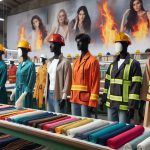When you think about fire-resistant fabrics, you might picture bulky, uncomfortable gear, but advancements in textile technology have changed that perception. These fabrics are designed to offer superior heat resistance, durability, and compliance with stringent safety regulations, making them indispensable in environments where fire hazards are a constant threat. Whether you're involved in firefighting, industrial work, or military operations, understanding the key properties and applications of these materials is essential. But what makes these fabrics truly innovative, and how do they balance protection with comfort? Let's explore the fascinating world of fire-resistant textiles.
Table of Contents
Key Takeaways
- Fire-resistant fabrics enhance safety and compliance in high-risk environments.
- Modern fabrics combine heat resistance, durability, and comfort for superior protection.
- Natural options like wool and synthetic fibers like aramids offer varied fire-resistant solutions.
- Innovative fabric technologies integrate sustainability and multi-layer protection.
- Proper maintenance and care extend the longevity of fire-resistant protective clothing.
Importance of Fire-Resistant Fabrics
Understanding the importance of fire-resistant fabrics can greatly enhance safety in various environments. You're likely aware that workplace safety isn't just a legal obligation but a moral one. Implementing fire-resistant fabrics in your protective gear can significantly reduce the risk of injury and ensure regulatory compliance.
In industries like construction, oil and gas, and manufacturing, where fire hazards are prevalent, these fabrics serve as a frontline defense. You need to stay ahead in an ever-evolving landscape, and that's where innovation and sustainable solutions come into play.
Modern fire-resistant fabrics are crafted not only to protect but also to minimize environmental impact. By opting for sustainable options, you're contributing to a safer workplace and a healthier planet. These advanced materials often incorporate recycled fibers and eco-friendly treatments without compromising on performance.
On top of that, integrating fire-resistant fabrics into your safety protocols can elevate your company's reputation. It shows that you prioritize both safety and sustainability, setting a standard of excellence. This proactive approach doesn't just meet regulatory requirements; it showcases your commitment to innovation and responsibility.
Key Properties of Fire-Resistant Materials
When selecting fire-resistant fabrics, you'll want to think about their heat resistance levels, which determine how well they can withstand high temperatures.
It's also important to assess the effectiveness of any chemical treatments applied to enhance fire resistance.
Heat Resistance Levels
Heat resistance levels in fire-resistant fabrics determine how well these materials can withstand high temperatures without degrading. When you're selecting protective clothing, understanding these levels is vital. Different fabrics exhibit varying degrees of heat resistance, and standardized tests guarantee that these materials meet industry requirements. You'll want to familiarize yourself with common fabric testing standards like ASTM F1959 and ISO 11612, which measure performance under extreme heat.
Here's a quick breakdown of some key metrics:
| Heat Resistance Level | Typical Use Case |
|---|---|
| Low | Basic fire-retardant clothing |
| Medium | Industrial workwear |
| High | Firefighter gear |
| Ultra-High | Specialized military applications |
In mastering this topic, remember that not all fire-resistant fabrics are created equal. You need to take into account the specific conditions they'll face. For example, firefighter gear requires a higher heat resistance compared to basic industrial workwear. By understanding and using these heat resistance levels, you can make informed decisions about the best materials for your protective clothing needs. This knowledge not only guarantees safety but also enhances performance and durability in high-stress environments.
Chemical Treatment Efficacy
Chemical treatment efficacy plays an important role in enhancing the fire-resistant properties of fabrics, guaranteeing they can withstand extreme conditions. You need to understand how chemical treatments can elevate the safety characteristics of textiles. These treatments operate by modifying the fabric at a molecular level, making it less likely to ignite and spread flames.
To truly grasp chemical treatment effectiveness, you should familiarize yourself with various fabric testing standards. These standards, such as ASTM D6413 or ISO 15025, provide a benchmark for evaluating how well a chemically treated fabric performs under fire exposure. Adhering to these standards ensures that the treatment not only works in theory but also holds up in real-world applications.
When evaluating chemical treatments, consider factors like durability and consistency. It's important to guarantee that the fire-resistant properties remain intact after multiple washes and prolonged use. Additionally, you should focus on how uniformly the treatment is applied across the fabric. Uneven application can result in weak spots that compromise safety.
Durability Under Stress
Durability under stress is vital for fire-resistant fabrics to maintain their protective qualities in challenging environments. When you're selecting fire-resistant materials, it's essential to understand how they perform under intense conditions.
Fabric stress testing evaluates a material's durability by simulating real-world scenarios, ensuring that the fabric can withstand wear and tear while retaining its fire-resistant properties.
You need a fabric that not only provides thermal protection but also exhibits high performance under physical strain. This means it shouldn't degrade or lose its effectiveness when exposed to friction, bending, or stretching.
Reliable fire-resistant fabrics undergo rigorous fabric stress testing to measure their resilience against both mechanical and thermal stressors.
Types of Fire-Resistant Fabrics
When considering fire-resistant fabrics, you'll find both natural fiber options and synthetic fiber innovations.
Natural fibers like wool and cotton can be treated to resist flames, while synthetic fibers such as aramid offer inherent fire resistance.
Understanding the benefits of each type will help you make informed choices for safety and functionality.
Natural Fiber Options
Among natural fiber options, wool stands out for its inherent fire-resistant properties. You might be surprised to learn that wool doesn't ignite easily and can self-extinguish when exposed to flames. This makes it an excellent choice for protective clothing.
Wool also offers sustainability benefits and is one of the most eco-friendly options available. Since it's a natural fiber, wool is biodegradable and renewable, reducing your environmental footprint.
But wool's appeal doesn't end there. Its breathability advantages and comfort features make it a superior material for fire-resistant clothing. Wool fibers have a natural crimp, creating tiny air pockets that allow for excellent insulation and moisture management. This means you can stay cool in the heat and warm in the cold, without compromising on safety.
Moreover, wool's ability to wick moisture away from the skin adds another layer of comfort, especially during strenuous activities. So, when you're looking for fire-resistant fabrics that combine effectiveness with sustainability and comfort, wool is a top contender.
Synthetic Fiber Innovations
Synthetic fibers have transformed the fire-resistant fabric industry with their advanced properties and versatile applications. By leveraging innovative blends, these fabrics offer unparalleled protection and durability, making them essential in high-risk environments. You'll find that synthetic fibers such as aramids, modacrylics, and polyimides deliver superior performance compared to natural fibers. Their ability to withstand extreme temperatures and resist degradation over time sets them apart.
In your quest for mastery, consider these key synthetic fiber innovations:
- Aramid fibers: Known for their exceptional strength and heat resistance, aramids are commonly used in firefighting gear and military uniforms.
- Modacrylic fibers: These fibers offer a balanced combination of flame resistance and comfort, making them ideal for protective clothing in industrial settings.
- Polyimide fibers: Renowned for their thermal stability, polyimides are used in environments where exposure to high temperatures is routine.
- Innovative blends: By combining different synthetic fibers, manufacturers can enhance both the protective qualities and wearability of the fabric.
Performance testing is essential in determining the effectiveness of these fire-resistant fabrics. Rigorous assessments guarantee that each material meets the stringent standards required for safety and durability. With synthetic fiber innovations, you're well-equipped to navigate the complexities of fire-resistant fabric solutions.
Innovations in Fabric Technology
Recent advancements in fabric technology have revolutionized fire-resistant materials, making them more effective and versatile than ever before. You're now seeing sustainability advancements that reduce environmental impact while enhancing fabric integrity.
Imagine fire-resistant materials crafted from recycled fibers or biodegradable components—these innovations aren't just eco-friendly; they also offer superior durability and longevity.
Fabric design innovations have led to the creation of textiles that aren't only fire-resistant but also lightweight and flexible, providing greater comfort and maneuverability.
Performance enhancements are equally impressive. Modern fire-resistant fabrics can withstand higher temperatures and offer better protection against direct flame exposure.
Material advancements have led to the development of fabrics that integrate multiple protective layers, each designed to counteract different threats like heat, chemicals, and abrasion.
These layers work in harmony, offering you all-encompassing protection without compromising on breathability or comfort.
Applications in Firefighting Gear
Leveraging these advanced fire-resistant fabrics, firefighting gear now offers unprecedented levels of protection and comfort for first responders. You can trust that the material advancements in modern gear make a significant difference in both safety and performance.
The integration of innovative design features guarantees that firefighters can move freely while staying protected from intense heat and flames.
Here's how these advancements are revolutionizing firefighting gear:
- Enhanced Durability: Modern fabrics are engineered to withstand extreme conditions, ensuring longer-lasting gear that maintains its protective qualities.
- Improved Breathability: Advanced materials allow for better air circulation, reducing heat stress and increasing comfort during prolonged use.
- Lightweight Construction: Despite their robust protection, these fabrics are lighter, making it easier for firefighters to perform their duties without added strain.
- Superior Heat Resistance: These fabrics provide excellent thermal protection, meeting stringent safety standards and excelling in performance testing.
Industrial Use Cases
Fire-resistant fabrics frequently find their way into industrial settings, offering essential protection for workers exposed to high temperatures and open flames. In these environments, adhering to strict safety standards is non-negotiable.
You'll find that manufacturing processes involving metalworking, chemical production, and petroleum refining demand the highest levels of protective gear. Fire-resistant clothing not only complies with workplace regulations but also significantly mitigates risks, ensuring a safer environment for your team.
When considering fire-resistant fabric solutions, you must evaluate the specific hazards associated with your industry. For instance, in metalworking, molten metal splashes can be a concern, while in chemical plants, exposure to reactive substances is common. By integrating fire-resistant fabrics into your safety protocols, you're not only meeting regulatory requirements but also promoting a culture of safety.
Emergency response readiness is another crucial aspect. Fire-resistant clothing can make a substantial difference during unforeseen incidents, providing that vital layer of defense when seconds count. Ensuring your workers are equipped with the best fabric technology can enhance their ability to respond swiftly and effectively.
Ultimately, investing in high-quality fire-resistant fabrics is a proactive step towards safeguarding your workforce and maintaining operational integrity.
Military and Tactical Applications
In military and tactical operations, reliable fire-resistant fabrics are essential for protecting personnel in high-risk environments. When you're out on the field, the last thing you want to worry about is whether your tactical uniform will hold up under extreme conditions. Fire-resistant fabrics are designed to provide you with that peace of mind, offering superior protection without compromising on comfort or flexibility.
When selecting military gear, consider these key benefits of fire-resistant fabric solutions:
- Enhanced Durability: These fabrics are engineered to withstand the rigors of combat and extreme conditions, ensuring your gear lasts longer.
- Thermal Protection: They provide a critical layer of protection against flash fires and explosions, reducing the risk of severe burns to a great extent.
- Comfort and Flexibility: Modern fire-resistant fabrics are designed to be lightweight and breathable, so you can move freely and stay comfortable during prolonged missions.
- Chemical Resistance: Many fire-resistant fabrics also offer resistance to hazardous chemicals, adding another layer of defense in unpredictable environments.
Maintenance and Care Tips
Proper maintenance and care are essential for maintaining the effectiveness and durability of your fire-resistant fabrics over time. To start, you need to prioritize regular fabric maintenance and cleaning. Always adhere to the manufacturer's guidelines for washing. Use mild detergents that don't contain fabric softeners or bleach, as these chemicals can degrade the fire-resistant properties. Wash your garments in warm water, and avoid high heat when drying to prevent shrinking or damage.
Equally important are storage tips. Store your fire-resistant clothing in a cool, dry place, away from direct sunlight and chemicals that could compromise their integrity. Hanging your garments can help maintain their shape and prevent creases that might weaken the fabric over time.
Routine inspections should be a part of your maintenance routine. Regularly check for signs of wear and tear, such as fraying, holes, or thinning fabric. Immediate repair or replacement of damaged areas maintains the garment's protective qualities.
Future Trends in Fire-Resistant Clothing
As technology advances, you'll see innovative materials and designs revolutionizing the future of fire-resistant apparel. The focus is shifting towards not just enhancing protection but also improving comfort, sustainability, and multifunctionality. Here are some emerging trends that you should watch closely:
- Flame Resistant Design: Expect to see more sophisticated flame resistant designs that offer superior protection without compromising flexibility or breathability. New weaving techniques and advanced coatings will play key roles.
- Sustainable Fabric Advancements: The industry is increasingly prioritizing eco-friendly materials. You'll find more fire-resistant apparel made from bio-based fibers and recycled materials, reducing the environmental impact.
- Smart Fabrics: Imagine clothing that can monitor your essential signs or adapt to temperature changes. Smart fabrics equipped with sensors and adaptive properties are on the horizon, offering not just safety but also enhanced functionality.
- Customization and Fit: Future fire-resistant apparel will offer better customization options to ensure a perfect fit. This is essential for maximizing both comfort and safety in high-risk environments.
Frequently Asked Questions
How Do Fire-Resistant Fabrics Differ From Flame-Retardant Treatments?
Fire-resistant fabrics are inherently non-flammable due to advanced fabric technology, while flame-retardant treatments are applied chemicals. Both meet safety regulations but differ in industrial applications and consumer options, ensuring you stay safe and compliant.
Are Fire-Resistant Fabrics Environmentally Friendly?
You're right to ponder if fire-resistant fabrics are eco-friendly. While some options are sustainable, it's important to research eco friendly alternatives. Prioritize sustainability factors when selecting materials to guarantee minimal environmental impact.
Can Fire-Resistant Clothing Be Customized for Individual Needs?
Like a tailored suit of armor, fire-resistant clothing can be customized for your individual needs. With various customization options, you guarantee personal protection that fits perfectly, blending safety with the precision of craftsmanship you desire.
What Are the Cost Differences Between Various Fire-Resistant Fabrics?
You'll find cost comparisons between fire-resistant fabrics show significant differences. While some options offer higher fabric durability, they may also come with increased maintenance costs. However, investing in quality can lead to long-term savings.
How Does Fire-Resistant Clothing Affect Comfort and Mobility?
Fire-resistant clothing affects comfort and mobility by balancing flexibility and breathability. High-performance designs guarantee you maintain agility, while advanced materials enhance overall comfort. Invest in well-designed gear for peak performance without compromising on protection.
- The History and Evolution of Chamois Fabric - June 22, 2025
- Chamois Fabric on Wikipedia: What You Need to Know - June 22, 2025
- How to Pronounce Chamois Fabric Correctly - June 22, 2025







